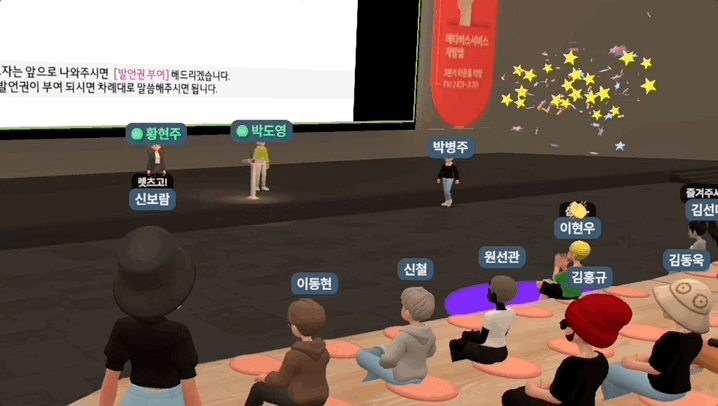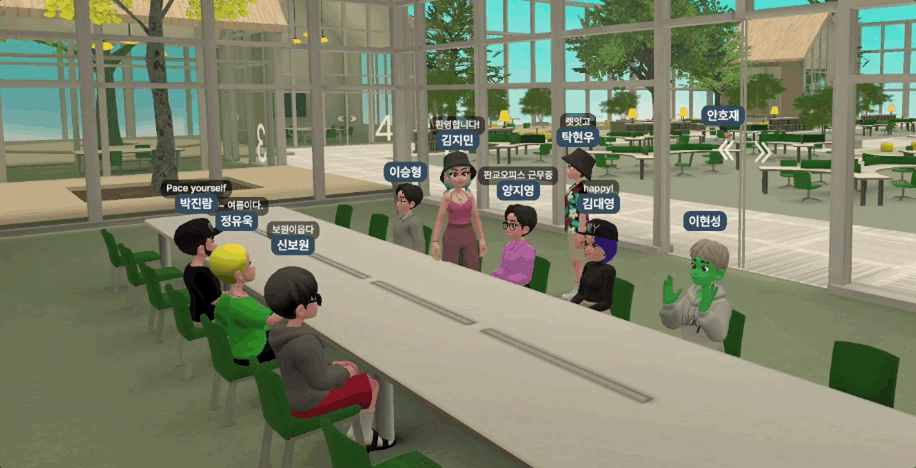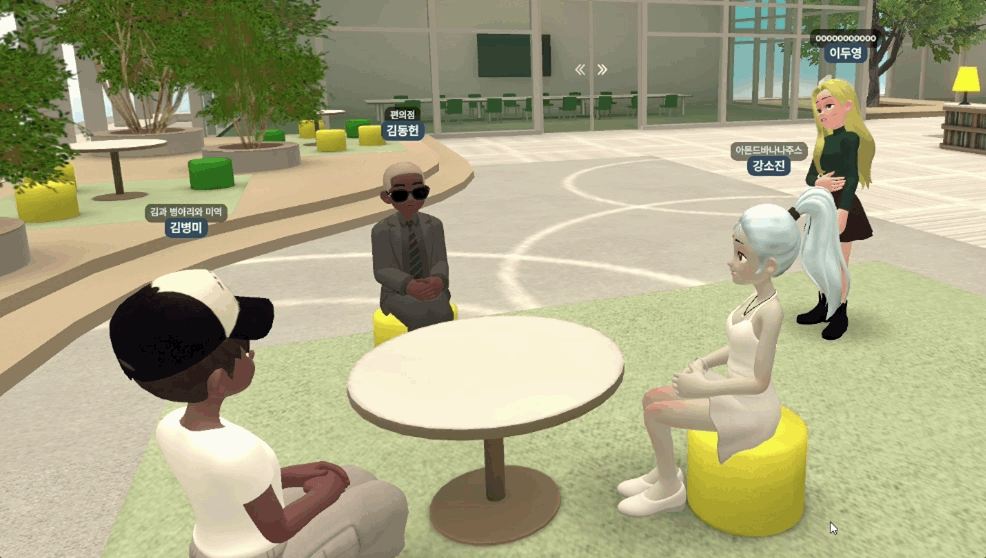From pixels to high-fives: LG U+ fosters real connections for virtual offices
Due to the COVID-19 pandemic, our daily lives became increasingly reliant upon non-face-to-face experiences, such as online conferences. LG U+ has developed a virtual office using Unity to address the challenges presented by this societal shift. Continue reading to learn how the team used Unity to make their hybrid office experience a reality.

The name of LG U+’s virtual office environment is Meta Slap, a combination of “meta,” which refers to the metaverse, and “slap,” which refers to the sound a high-five makes. This nomenclature symbolizes the LG U+ philosophy of getting together and communicating plus the joy felt when high-fiving. When developing the project, the team focused on solving realistic distance and space constraints, providing a sense of realism and coexistence through fun interactions, and facilitating communication that connects people via avatars and real encounters.
Choosing Unity
After finding it difficult to work with conventional 2D user interfaces, such as video conferencing, LG U+ realized that offering rich person-to-person experiences could be achieved with a more realistic and interactive environment. Consequently, the team considered improving the user experience by creating a virtual space that fostered interactivity. It was therefore crucial to determine the most efficient way to create, iterate, and test a minimum viable product (MVP).
To start, they identified Unity, the only 3D engine that met their four user requirements, as the best starting point for their solution:
- Developer tools and templates for creating virtual spaces quickly and easily
- Ability to run on a typical work PC
- Multiplatform support for end-user devices, including mobile
- A rich library of assets and code
Project evolution
In the early stages of Meta Slap’s development, the team had absolutely no experience developing for the metaverse. The introduction of Unity, however, was a major factor in setting the direction of the project – it allowed them to easily combine existing assets and other resources. As well, their planning, iteration, and verification processes proceeded quickly.
Another benefit of choosing Unity was the ease that LG U+ had collaborating with experts in Unity’s global offices. They tapped Unity expertise on 3D modeling, project design, development best practices, quality assurance, and much more, enabling them to advance through each stage with confidence to reach their end goals.

Implementing a virtual office
The primary focus of the design for the virtual office space was to facilitate communication between colleagues. In order to do this effectively, they created an open plan featuring worktables for large and small groups. For company town halls, podiums and audience seats were designed to create a sense of realism and increase audience concentration in a way that matches the purpose of the space. Customers really like these modifiable spaces because they allow departments and teams to put up their own banners or logos for different events and purposes.

The team also designed a lobby to provide a sense of going to work and a place for small talk when people log in. Like with the town halls, the lobby has customizable features that can reflect a company’s identity or be used for advertising. Additionally, users have shared that the gamification elements encourage communication and user interaction.
Moreover, LG U+ has found that customer satisfaction is higher in scenes with a clear purpose and a strong sense of realism, such as those involving in-house events and educational programs.
Project optimization

Similar to 3D games, Meta Slap requires real-time rendering, though it’s also a work environment. While the company’s customers are familiar with Web 2.0 and utilize environments that are optimized for it, most of their low-spec PCs are not suitable for 3D applications, therefore it was necessary to optimize Meta Slap to work seamlessly on lower-end devices.
As a result, the team invested a significant amount of time and effort in finding ways to minimize the use of resources during rendering. Various optimizations have been made to the graphics resources, including minimizing polygons in 3D modeling and draw calls. They also considered ways to optimize the use of PC resources, such as automatically adjusting the frame rate based on user actions.
As well, the team invested considerable effort optimizing Meta Slap to bridge existing user interfaces, such as video conferencing, with the new interactivity. When combining familiar functions like chat and voice communication with functions from games, such as synchronization and gestures, there were challenges, though the team found a workable balance between the older and newer tech.

Avatar entry and exit
To enable smooth avatar movement in Meta Slap, the team designed separate spaces that allow the avatars easy entry and exit when engaging in or leaving a conversation. They also used real-time communication (RTC) solutions for both distance- and space-based conversations, as well as screen-sharing at town hall presentations.
- Connections based on distance: When the prototypes of the first two user avatars meet, a CallArea (purple circle) from a client of the user with a small ID in the database is created. For other connected users, the avatar’s CapsuleCollider must touch the area to allow the conversation to occur.
- Connections based on space: A BoxCollider is placed in each area and the SmallTalk class is used as a component. Each class holds the IDs of users within the collider and sets it so that video cards are added or removed based on the IDs of the corresponding small-talk area when users enter or exit.
During the implementation of the avatar, the Low Poly test version of the base body was applied and the Simple Lit shader was used. Parts were applied in a Full Poly version and assembled with the base body using the Stylized Lit shader.
The next phase of development
Communication between multiple participants is the most important feature in Meta Slap. As a result, LG U+ developers are now focusing on connecting participants in a more stable manner. Therefore, in future updates, they plan to construct the spatial composition by focusing on scenes that are more satisfying to users and that can effectively showcase the unique advantages of Meta Slap.
Following a month of beta testing, the team received much positive feedback. The initial users indicated they felt a sense of community and realism outside the typical company hierarchy. The team is focusing on these organizational benefits while developing enhanced features.
Future plans, including AI
Since the beginning of the planning process, LG U+ has been quite interested in AI and they feel that introducing it is essential for rich user experiences in the Meta Slap spaces. The team plans to take advantage of Unity AI soon and has high expectations for what it can do for their users. For example, they anticipate being able to provide AI functionality that will provide easy access to information and help users quickly adapt to the virtual environment.
“I believe that the age of Web 3.0 is going to be 3D, and Unity is the foundation for 3D engines. In the future, Unity’s use cases are expected to expand, not only to higher-performance computers and smartphones but also to everyday services that will naturally expand the real-world experience as experiential devices become more prevalent.” – Hyun-woo Lee, Meta Slap project owner at LG U+
Finally, LG U+ is excited to be creating an effective and interactive workplace solution tailored to the needs of customers and individual users. It’s the team’s goal to build a number of target-specific, purpose-based services that they hope will result in further optimizing employee communications and processes. The Unity Engine provides the foundation for their goals.
Learn more about Meta Slap today, then check out additional blog posts from Unity creators.
Is this article helpful for you?
Thank you for your feedback!
- Unity Labs
- Copyright © 2024 Unity Technologies